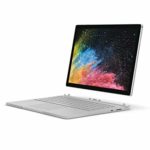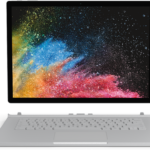To Overclock Surface Book 2 you need to unlock the processor. Since the processor is locked you have to unlock this processor illegally and perform overclocking.
About Microsoft Surface Book 2
- Surface Book 2 comes with sleek silver magnesium finishing with a great keyboard.
- The laptop comes with a larger 15-inch screen which maintains 4K quality with 3240 x 2160 PixelSense Display.
- Surface Book 2 is powered by a 1.9 GHz Intel Core i7-8650U Quad-Core processor and 16GB of RAM.
- For storage, it provides 256GB SSD.
- The laptop supports a 6GB GDDR5 Graphics card NVIDIA GeForce GTX 1060.
- Furthermore, it has ports including two USB-A 3.1 ports, one USB-C port, a headphone jack, a Surface Connector, and an SD card reader.
- Other then great design and performance it also supports a 1080p Camera.
- Lastly, Windows 10 64-bit OS is pre-installed in Microsoft Surface Book 2.
What is Overclocking?
Overclocking is the process of speeding up or increasing the clock speed than official efficiency provided by Manufacturers. In other words, overclocking is the method of configuring the hardware components to obtain extra utility and performance than the default. We have to take many precautions while overclocking your Intel Core i7-8650U.
Read also – Is overclocking Ram a safe process?
Remember: Overclocking can result in damage
Overclocking is a method triggering the main processor or graphics controller, but systems such as RAM are also involved in this process which leads to an increase in power consumption and fan noise. Due to overclocking many manufacturers gives the extra functionality of safety to deal with operating conditions outside the control of manufacturers. The disadvantage of overclocking your Intel processor is overheating and more power usage. Ultimately, heating will result in decreasing the life span of your CPU.
Read also – Is it safe to overclock my Nvidia Gtx 1080 ti?
Since Overclocking is not possible on your Surface Book 2 we will be using Intel Turbo Boost technology to improve the performance.
What is Intel Turbo Boost Technology?
- Intel Turbo Boost Technology is the feature in Intel’s processors which raises the operating frequency whenever there is high demanding task running.
- Furthermore, the feature accelerates the frequency of the processor when the operating system demands high performance.
- The Turbo boost concept can also be called as “Dynamic Overclocking”.
- This feature is enabled in the processors including Core i5, i7, i9, and Celeron processors.
Remember: Overclocking is never a safe process while a turbo boost is always safe.
About Intel Core i7-8650U
- Manufacturer: Intel
- Product Segment: Mobile
- Base Frequency: 1.90 GHz
- Lithography: 14 nm
- Maximum Turbo Frequency: 4.20 GHz
- Cache: 8MB
- TDP: 15W
- Maximum Memory Size: 32GB
- Cores: 4
- Threads: 8
Full Specs
Why you cannot overclock Intel Core i7-8650U?
- A CPU Locking is done to lock the clock multiplier permanently or till the clock limit is not removed.
- So it is a restriction on overclocking or to protect the CPU from further damages.
- These locked models are denoted with ‘K’ in Intel and ‘Black’ for the AMD
- Lastly, If you want to overclock your Intel Core i7-8650U then you have to unlock if possible.
List of all Unlocked Processors
To Enable or Disable Intel Core i7-8650U Turbo Boost
- To enable or disable Turbo Boost in Intel Core i7-8650U
- Select From the System Utility screen
- and press Enter.
- Select a setting and press Enter.
- Enabled: To Enable hyperthreading technology.
- Disabled – To reduce power usage and get stable performance.
- Finally, Press F10
- To monitor your CPU you can download and install CPU-Z and ThrottleStop
- Lastly, the Turbo boost is an automatic function provided in Intel processors.
Read also –
- Can I Overclock Intel Atom x5-Z8300 Processor
- Is Intel Atom x7-Z8700 Overclock Possible or not
- How to overclock Snapdragon 439 processor
Problem not solved yet? Ask a Question






![Microsoft Surface Book 2 Screen Flickering Problem [Solved] Microsoft Surface Book 2 Screen Flickering Problem [Solved]](https://www.infofuge.com/wp-content/uploads/2019/08/images-24-150x150.jpg)
![Microsoft Surface Book 2 Slow Performance Problem [Solved] Microsoft Surface Book 2 Slow Performance Problem [Solved]](https://www.infofuge.com/wp-content/uploads/2019/08/surface-book-2-150x150.jpg)